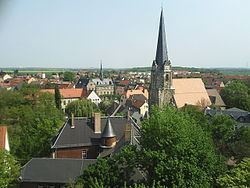Time zone CET/CEST (UTC+1/+2) Area 96.48 km² Local time Thursday 1:29 AM | Elevation 220 m (720 ft) Postal codes 06679, 06686 Population 7,826 (31 Dec 2008) | |
 | ||
Weather 4°C, Wind SW at 8 km/h, 83% Humidity Points of interest Tierpark Lützen, Gustav‑Adolf‑Denkmal, Museum im Schloss Lützen | ||
Lützen is a town in the Burgenlandkreis district of Saxony-Anhalt, Germany.
Contents
Map of L%C3%BCtzen, Germany
Geography
It is situated in the Leipzig Bay, approximately 10 km (6.2 mi) southwest of the Leipzig city limits and 14 km (8.7 mi) northeast of Weißenfels. The town has access to the Bundesstraße 87 road from Leipzig to Weißenfels as well as to the Bundesautobahn 9 (at the Bad Dürrenberg junction) and the Bundesautobahn 38.
The municipal area comprises the villages of
History
Held by the Prince-Bishops of Merseburg, Lützen Castle from the 13th century onwards was the seat of the local administration (Amt). After the 1485 Treaty of Leipzig, the town increasingly fell under the Wettin electors of Saxony, until the episcopal lands were finally secularised in 1547; from 1656/57 until 1738 it was held by the secundogeniture of Saxe-Merseburg.
The town was the scene of two famous battles:
By 1815 resolution of the Vienna Congress, Lützen fell to the Prussian province of Saxony. Part of the Soviet occupation zone after World War II, the town belonged to the East German district of Halle from 1952 to 1990.
Politics
Seats in the town's assembly (Stadtrat) as of 2014 local elections:
